



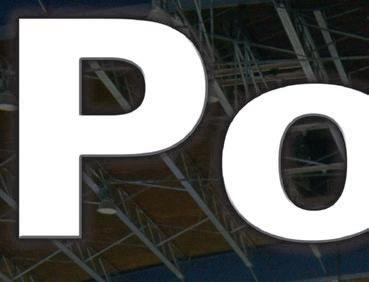

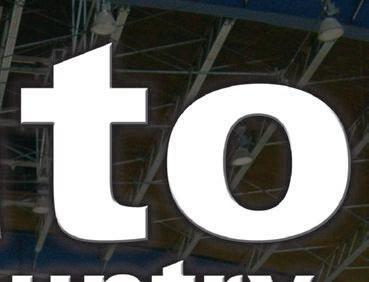













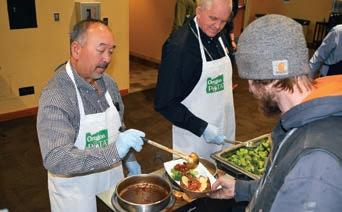
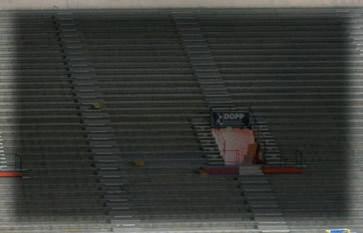
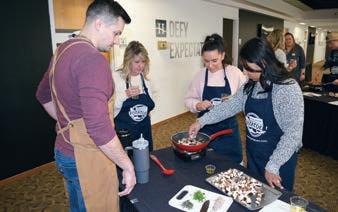

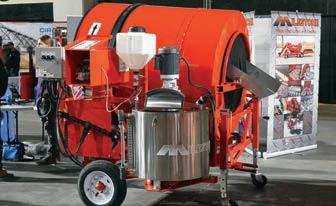


Western Show Wrap-Ups Growth Essentials • New Products • Managing Stem Number With Growth Regulators PotatoCountry.com • March/April 2023 Western focus. National impact. Ag World ............................17 Bayer ....................................2 Colorado Seed ....................27 Corteva...............................13 Greentronics.......................10 ICL ........................................3 Idaho Potato Comm.. ............9 Idaho Seed .........................23 Montana Seed ....................14 NovaSource ........................25 Nutri-Cal .............................19 Oro-Agri .............................32 Redox .................................11 Rivers West Auctions ..........26 Skone Irrigation ..................30 SpudEquip.com ..................15 Stukenholtz ........................29 The Potato Podcast Sponsored by Vive ..............23 Teleos .................................31 Titan ...................................21 TKI ........................................5 Verbruggen.........................24 ADVERTISER INDEX






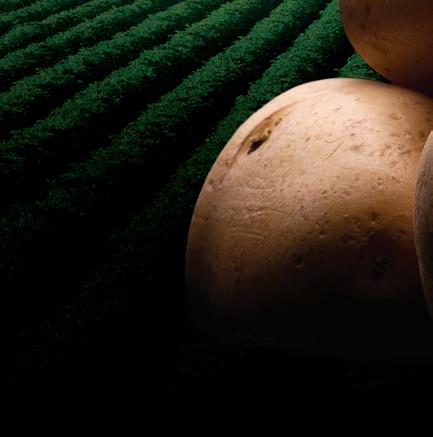





Tackle white mold with a new defensive all-star. Introducing Luna® Pro fungicide, the newest member on the Force in the Field team and the defensive rookie of the year. It’s our rst potato fungicide to combine an SDHI and DMI for excellent protection. Learn more at LunaPro.us. ALWAYS READ AND FOLLOW PESTICIDE LABEL DIRECTIONS. Not all products are registered for use in all states and may be subject to use restrictions. The distribution, sale, or use of an unregistered pesticide is a violation of federal and/or state law and is strictly prohibited. Check with your local dealer or representative for the product registration status in your state. Bayer, Bayer Cross, and Luna® Pro Fungicide are registered trademarks of Bayer Group. For additional product information, call toll-free 1-866-99-BAYER (1-866-992-2937) or visit our website at www.BayerCropScience.us. Bayer CropScience LP, 800 North Lindbergh Boulevard, St. Louis, MO 63167. ©2023 Bayer Group. All rights reserved. NEW
Unlock your soil P potential

Even in high-phosphorus soils, phosphorus is often unavailable to growing tubers. ICL’s dual-purpose acidifiers, Nova PeKacid and Agrolution pHLow unlock soil nutrient reserves plus provide a boost of P for increased nutrient efficiency and improved yield and quality. Learn more.
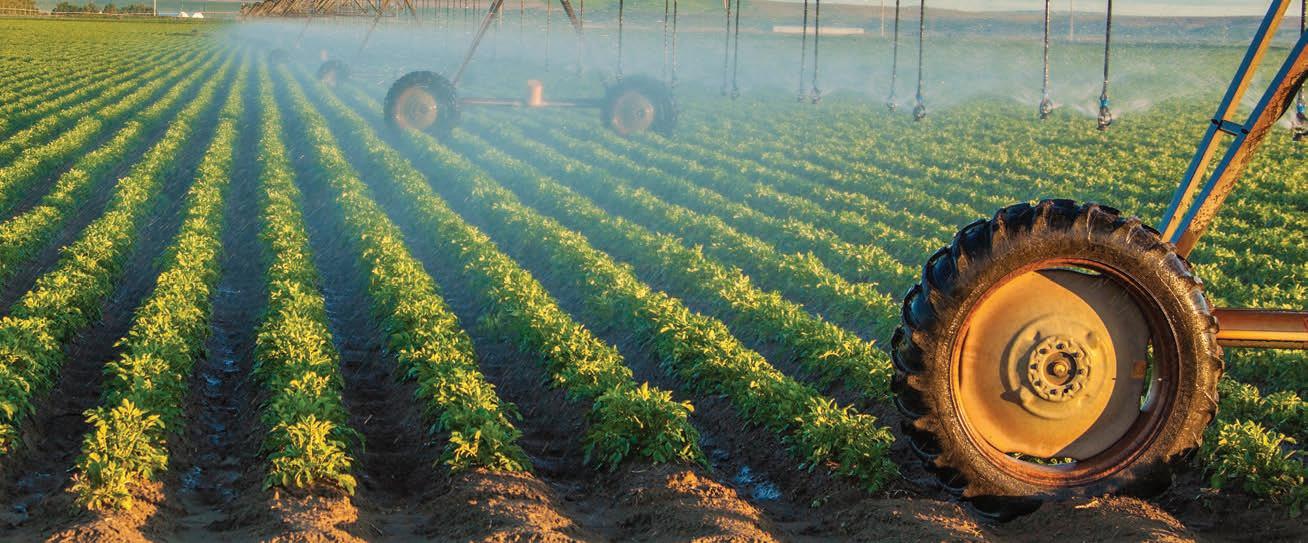
Make the most of your phosphorus with Agrolution pHLow and Nova PeKacid icl-growingsolutions.com

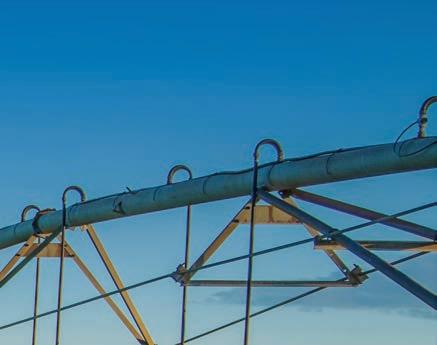


PO Box 333, Roberts, Idaho 83444
Telephone: (208) 520-6461
Circulation: (503) 724-3581
PotatoCountry.com
EDITOR
Denise Keller editor@ColumbiaMediaGroup.com

OPERATIONS MANAGER, ADVERTISING

Brian Feist brian@ColumbiaMediaGroup.com
PUBLISHER, ADVERTISING

Dave Alexander dave@ColumbiaMediaGroup.com
INSECT IDENTIFICATION
Andy Jensen www.nwpotatoresearch.com
DISEASE IDENTIFICATION
Jeff Miller jeff@millerresearch.com




MARKET REPORT
Ben Eborn napmn@napmn.com
POTATO GROWERS OF WASHINGTON

Dale Lathim dale@pgw.net
EDITORIAL INFORMATION
Potato Country is interested in newsworthy material related to potato production and marketing. Contributions from all segments of the industry are welcome. Submit news releases, new product submissions, stories and photos via email to: editor@ColumbiaMediaGroup.com.
ADVERTISING SALES
For information about advertising rates, mechanics, deadlines, etc., call (208) 520-6461 or email dave@PotatoCountry.com.
SUBSCRIPTIONS
U.S. $24 per year / Canada $40 per year / Foreign $80 per year Subscriptions can be entered online at: potatocountry.com/subscribe or call (503) 724-3581. Email address changes/corrections to: brian@ColumbiaMediaGroup.com or send to
Potato Country, PO Box 333, Roberts, ID 83444.
Potato Country magazine (ISSN 0886-4780), is published eight times per year and mailed under a standard rate mailing permit at Idaho Falls, Idaho and at additional mailing offices. It is produced by:
Columbia Media Group, PO Box 333, Roberts, ID 83444
Copyright 2023. All rights reserved. No part of this publication may be reproduced or transmitted in any form or by any means, electronic or mechanical, for any purpose without the express written permission of Columbia Media Group.
4 Potato Country • March/April 2023
Gary Roth Executive Director Oregon Potato Commission (503) 239-4763 Jamey Higham President/CEO Idaho Potato Commission (208) 334-2350 Nina Zidack Director Montana Seed Potato Certification (406) 994-3150 Jim Ehrlich President/CEO Colorado Potato Commission (719) 852-3322 EDITORIAL BOARD Country Western focus. National impact. Vol. 39 No. 3 MARCH/APRIL 2023 24 In the News 25 Calendar 26 New Products 30 PGW Column 30 Advertiser Index SunRain displays its potato varieties at the Washington-Oregon Potato Conference. See other shots from the show on pages 12-16. Exhibitors and attendees make the most of the Idaho Potato Conference and Eastern Idaho Ag Expo (left and center) and the Washington-Oregon Potato Conference (right). Find highlights from the shows on pages 6-8 and 12-16. TABLE OF CONTENTS Chris Voigt Executive Director Washington State Potato Commission (509) 765-8845 ON THE COVERDEPARTMENTS 6 Reputation Idaho Potato Conference and Eastern Idaho Ag Expo 10 Disease Management: A Moving Target Idaho Seed Potato Growers Seminar 12 Myth Busting Washington-Oregon Potato Conference 18 Managing Stem Number With Growth Regulators 20 Growth Essentials Buyers' Guide 28 Factors Driving 2023 Planting Decisions Market Report










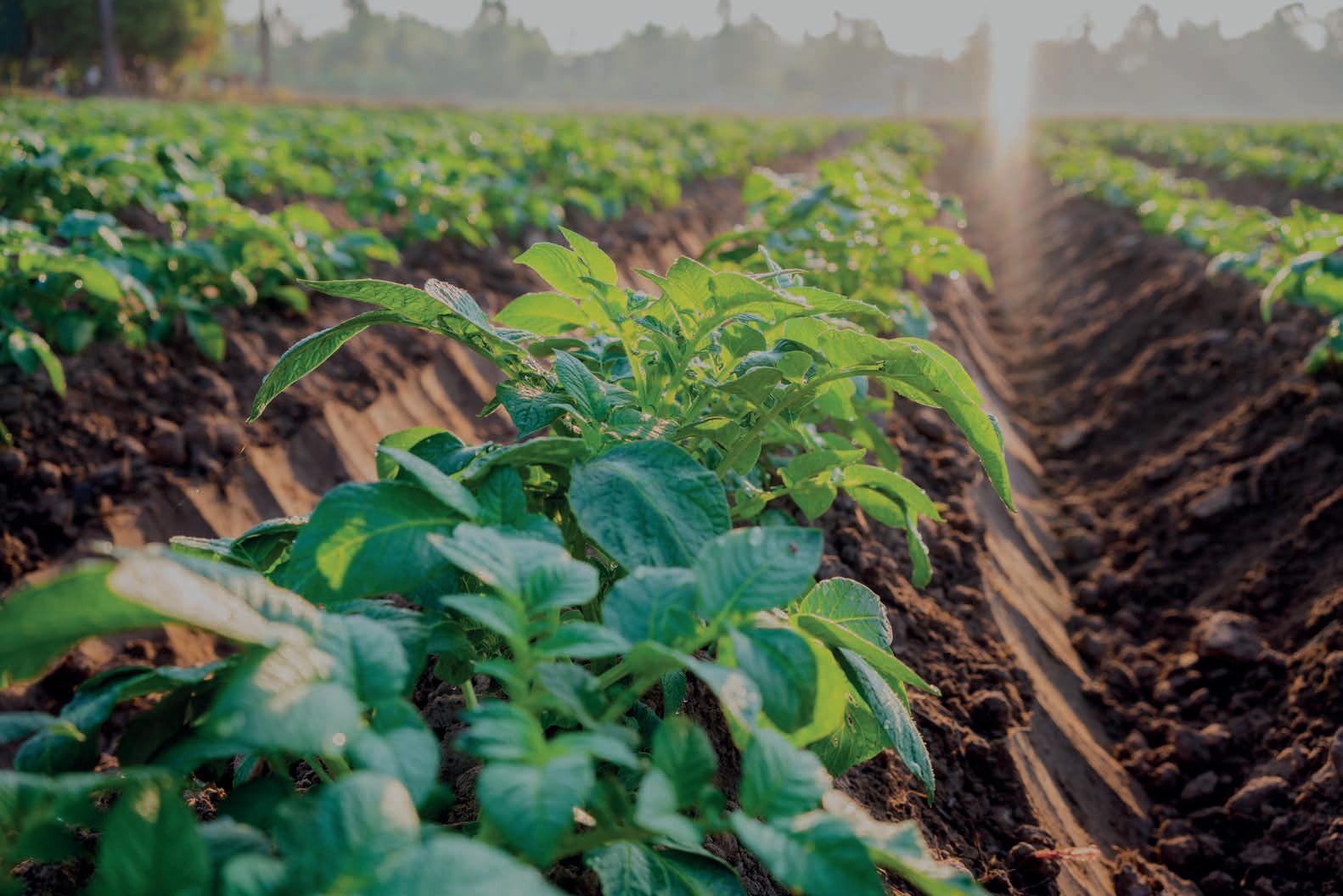


Keeping Potatoes in a Positive Light
Story and
 by Dave Alexander, Publisher
by Dave Alexander, Publisher
The reputation of the Idaho Potato Conference and Eastern Idaho Ag Expo in Pocatello, Idaho, is well known in the potato industry as a first-rate conference, well worth attending. This year’s show ran Jan. 17-19, and, as always, the floor of Idaho State University’s Holt Arena was crammed with new farming equipment, and the educational sessions were packed with attendees.
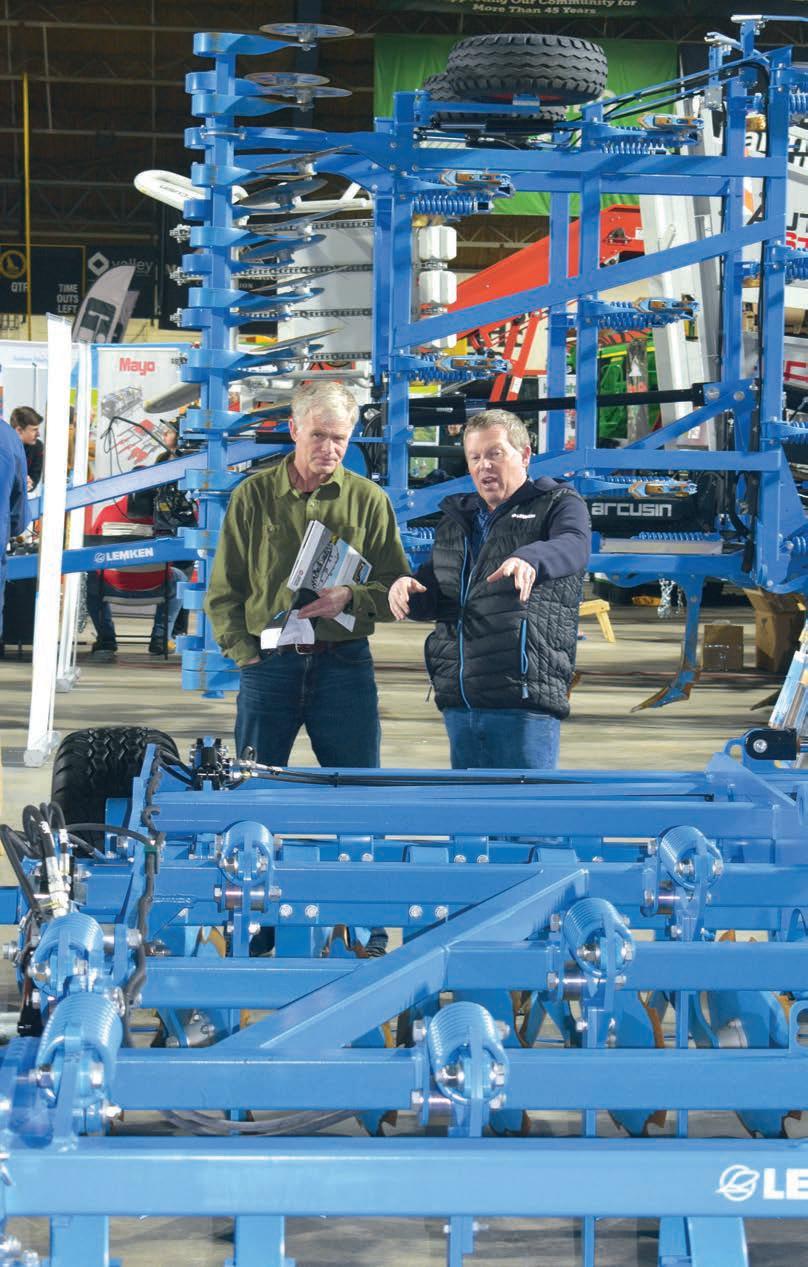
The sessions featured a wide variety of subjects in English and Spanish. Topics included soil health, pest management, storage and a series of “Potatoes 101” talks, all delivered by noted researchers. The CEOs of Potatoes USA and the Idaho Potato Commission were also on hand in Pocatello, keeping attendees up to date on the latest news. Their job is to not only market potatoes at large, but also to keep America’s favorite vegetable in a positive light and boost the humble spud’s reputation.
Healthy Choice
Jamey Higham, president and CEO of the Idaho Potato Commission (IPC), brought some exciting news from Boise. Though final details are still in the works, the IPC has entered into a marketing agreement with the American Diabetes Association (ADA).
Higham stated that according to the CDC and the ADA, almost 50 percent of adults in the U.S. are living with diabetes or pre-diabetes, and many of those people firmly believe they cannot eat potatoes.
“We’ve set out to change that mindset,” Higham said.
To help change the perception that potatoes are an unhealthy source of carbs, the IPC has entered into a threeyear arrangement with the ADA. The aim is to help people understand that
Reputation
photos
IDAHO POTATO CONFERENCE AND EASTERN IDAHO AG EXPO
Attendees discuss the merits of Lemke design in a booth at Holt Arena in Pocatello, Idaho.
potatoes can be part of healthy eating habits for all, including those with diabetes. Idaho potato growers and packers will soon be able to use the ADA’s “Better Choices for Life” logo on 5- and 10-pound bags of Idaho potatoes. This logo helps guide supermarket choices for tens of millions of Americans and should have a significant impact on the potato’s nutritional standing with consumers.
“I believe a rising tide lifts all boats and think this is going to be good for our entire industry as a whole, and it was right for us to do it,” Higham stated.

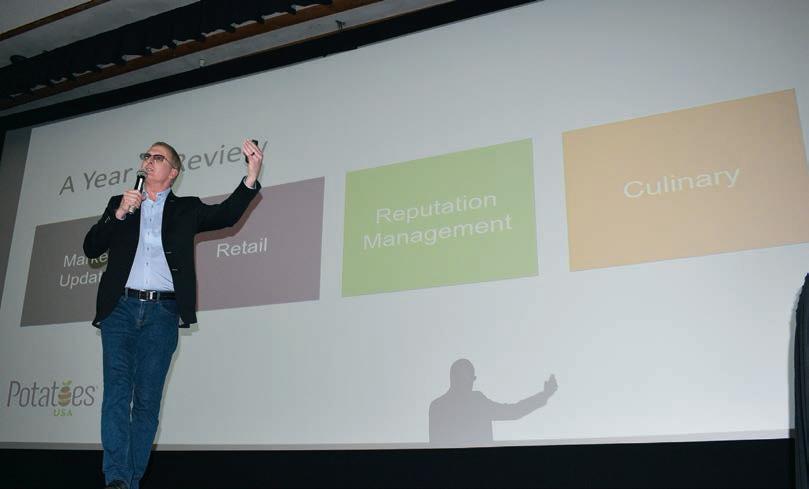
Reputation Management
Potatoes USA is also doing its part to uplift the reputation of potatoes. During his address to attendees in Pocatello, Blair Richardson, CEO of Potatoes USA, said about two years ago Potatoes USA started fighting back aggressively when negative, incorrect or biased information was published about potatoes. When Potatoes USA staff finds such stories, they contact the writers, editors, publishers and even researchers who put the articles together. Potatoes USA has the knowledge gained from $20 million in research to better understand the health and nutritional benefits of potatoes to help argue the case.
Well-armed with this fact-based science from the Alliance for Potato Research & Education (APRE), Richardson’s group seeks retractions and corrections to negative stories about potatoes. Richardson said it is not easy to get articles changed, but Potatoes USA has had a 39 percent success rate in doing so. Most groups would be elated with a 10 percent change rate, he said.
Potatoes USA is waging a two-year, ongoing battle with the Culinary Institute of America. In its guiding initiatives to get restaurants and foodservice outlets to cook healthier, the Institute recommends limiting potatoes. Spuds are the only vegetable called out in a negative way on the guidelines.
“We’re really close to getting to the point where they will remove that,” Richardson said.
Due to personnel changes at the Institute and Potatoes USA’s constant efforts, Richardson expects the “limit potatoes” verbiage to be dropped in the
 Stetson, Payson and Lindsay Searle from Shelley, Idaho, check out a new John Deere tractor.
Potatoes USA CEO Blair Richardson tells attendees in Pocatello, Idaho, that the number of positive stories about potatoes outweighs the negative by 13 to 1 on social media, 3 to 1 on traditional media.
Logan displays its heavy-duty Tare Pro conveyor at the Eastern Idaho Ag Expo.
Stetson, Payson and Lindsay Searle from Shelley, Idaho, check out a new John Deere tractor.
Potatoes USA CEO Blair Richardson tells attendees in Pocatello, Idaho, that the number of positive stories about potatoes outweighs the negative by 13 to 1 on social media, 3 to 1 on traditional media.
Logan displays its heavy-duty Tare Pro conveyor at the Eastern Idaho Ag Expo.
next 12 to 18 months.
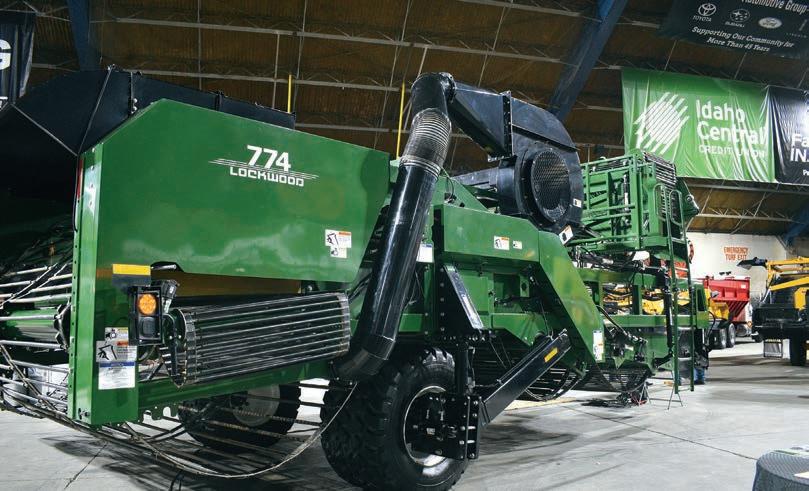

“We’re really trying to keep the reputation of the potato in a positive light, and we’ve done a lot more work on that in recent years,” Richardson stated.
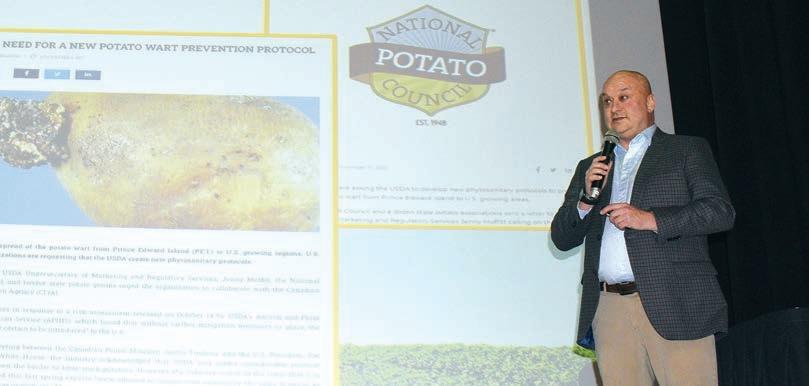
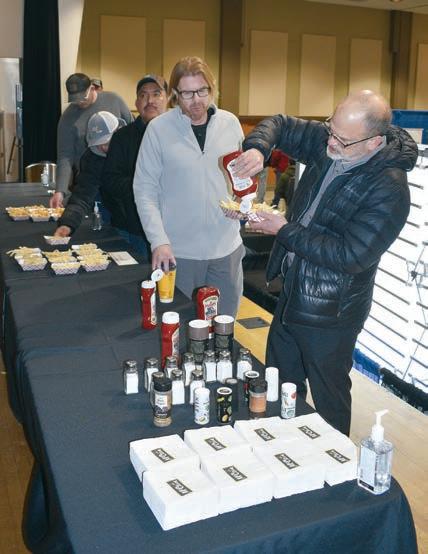
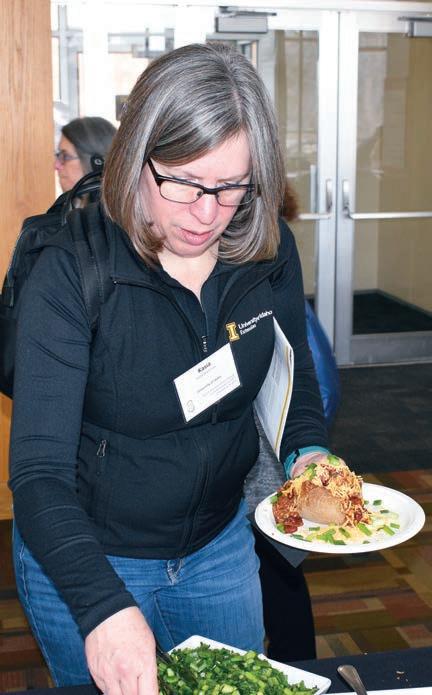 Kasia Duellman with the University of Idaho selects toppings at the Teton Russet potato bar during the Idaho Potato Conference. Duellman gave several presentations at the conference.
The French fry table is always a big hit.
It takes several people to push these massive Group Ag electrical cabinets into place under the snarling Idaho State University Bengal tiger.
Kasia Duellman with the University of Idaho selects toppings at the Teton Russet potato bar during the Idaho Potato Conference. Duellman gave several presentations at the conference.
The French fry table is always a big hit.
It takes several people to push these massive Group Ag electrical cabinets into place under the snarling Idaho State University Bengal tiger.
IDAHO POTATO CONFERENCE AND EASTERN IDAHO AG EXPO
The 774 is the newest harvester in the Lockwood lineup.
Mike Wenkel, chief operating officer with the National Potato Council (NPC), speaks in Idaho. The NPC is currently focused on a number of issues affecting growers, including a new farm bill and keeping potato wart-infected potatoes out of the U.S.
The Idaho Potato Commission is proud to announce our new partnership with the American Diabetes Association and participation in the Better Choices for Life program. Nearly one in two American adults are living with diabetes or prediabetes, and together we hope to help educate them about how Idaho® Potatoes can be safe to eat and a healthy source of carbohydrates.

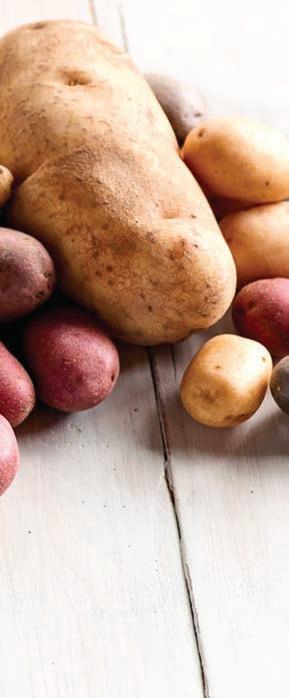

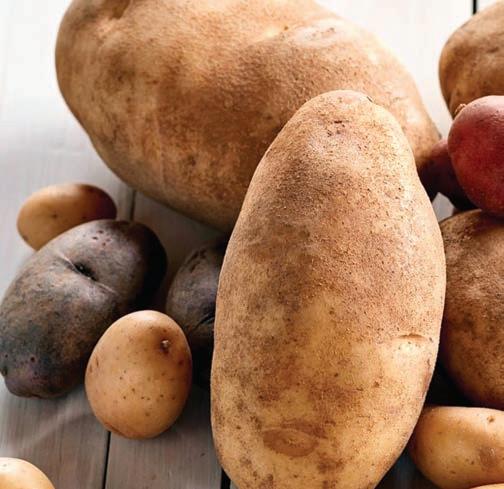


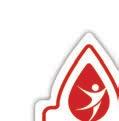
IdahoPotato.com
It’s more than a new relationship with The American Diabetes Association, it’s a new relationshipwith 1 in 2 Americans.
Disease Management: A Moving Target
Story and photos by John O’Connell, University of Idaho
Oncethe scourge of the seed potato industry, potato leafroll virus is now all but forgotten.
However, University of Idaho plant virologist Alexander Karasev warns conditions may be aligning for leafroll to make an unwanted comeback.
Karasev believes the rollercoaster ride the industry has faced in dealing with leafroll throughout several decades is a prime example of how controlling potato seed pathogens presents a moving target. Problems of the past may resurface as variables shift, and as soon as one challenge is resolved, another issue is apt to emerge.
Karasev offered his insights during a speech, “Potato Disease Control,
Changing Targets Over Time,” on Jan. 17 during the 54th Annual Idaho Seed Potato Growers Seminar in Pocatello, Idaho.
“You have multiple factors involved in the possible introductions of new pathogens and vectors,” Karasev said. “All of these may affect the relative significance of different pathogens for potato certification. It’s like a living organism, so don’t think it’s going to be like this forever.”
Potato leafroll virus, which is spread by colonizing aphids, was historically responsible for yield losses in excess of 50 percent. Infected plants become stunted and produce smaller tubers with necrosis of the vascular tissue. The
arrival of the pesticide DDT effectively controlled colonizing aphids, and leafroll took a backseat to other concerns. In the 1970s, leafroll returned with a vengeance due to the ban on DDT.
In the early 2000s, a new group of chemicals, neonicotinoids, was released, which once again relegated leafroll to a minor issue.
“There are practically no colonizing aphids in the fields anymore, so there’s practically no leafroll in potato fields,” Karasev said.
However, several states have restricted neonicotinoid use based on concerns for pollinators, and the future of the group of chemicals is uncertain. The onset of resistance to neonicotinoids could also pose a problem.

“Especially for leafroll, I’m urging people to keep an eye on regulations. The chemistry that is available today may be banned tomorrow,” Karasev said. “In this case, you will have an outbreak of leafroll.”
Also on the Radar
In about 2002, shortly after leafroll again left the industry’s radar, another aphid-vectored disease – Potato virus Y (PVY) – emerged as a major threat that has become the primary reason for seed lot rejections. Unlike with leafroll, aphids can pick up PVY within seconds of feeding and spread it long before insecticides have a chance to take effect.
Some potato cultivars were bred with PVY resistance. However, they were developed in the early 2000s to resist the predominate strain at the time, PVY-O. Today, the strain PVY N-Wilga comprises more than 70 percent of infections, followed by PVY NTN, rendering some of the resistant cultivars less effective.
A couple of other diseases that used to be devastating for seed potato growers have been held in check because of the advent of using tissue cultures –
10 Potato Country • March/April 2023
IDAHO SEED POTATO GROWERS SEMINAR
plants grown from stem fragments in an artificial medium within a laboratory to produce clean early-generation seed.


Potato spindle tuber viroid was a major problem in the early days of seed certification but was declared eliminated in North America in the mid-1980s thanks to the use of tissue cultures in seed propagation.
Bacterial ring rot, once the primary reason for seed lot rejections and now relatively rare, is another success story resulting from the industry’s adoption of tissue cultures.
Looking ahead, potato mop-top virus –a pathogen that’s most efficiently spread through soil – looms as a new threat. Since 2011, it’s been found in every major potato producing state. It’s spread by the vector Spongospora subterranea, which also causes the disease powdery scab. Potato mop-top virus is currently not covered by the state’s potato seed certification program, a problem Karasev feels should be remedied.




“It’s not tested for. Technically, there is no control of any sort at the moment,” Karasev said. “This is something that industry might need to think about.”





















Karasev advises potato growers and agronomists to be vigilant and to report anything out of the ordinary in their fields.

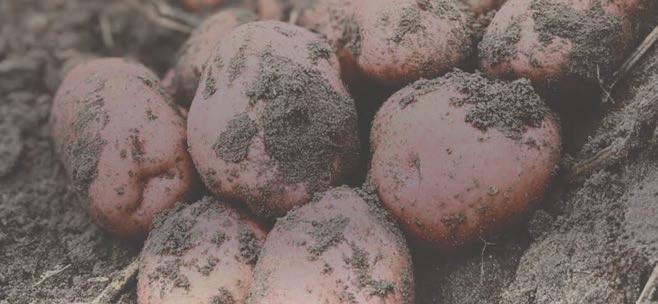



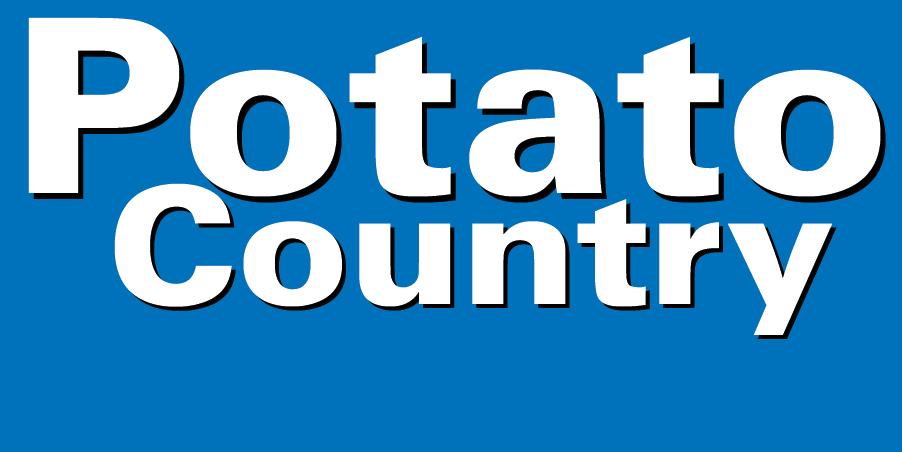
“Remember that it all changes,” Karasev said. “You can never rest if you are a potato grower.”






























PotatoCountry.com 11
FREE INDUSTRY NEWS TO YOUR INBOX PotatoCountry.com/ NEWSLETTER Units of Phosphorus Applied Grower Standard Redox Program Units of Applied Phosphorus 0 20 40 60 80 100 94 6 Yield Grower Standard Redox Program CWT Per Acre 600 620 640 660 680 700 682 692 Scan to see the results Contact us for more information at (208) 678-2610 @redoxgrows redoxgrows.com The
LISTEN TO OUR NEW REDOX GROWS PODCAST Scan the QR code to listen to our Podcast
Alex Karasev, University of Idaho potato virologist, discusses the evolution of potato viruses during the Idaho Seed Potato Growers Seminar in Pocatello, Idaho.
use of Redox products improved phosphorus e ciency by 93.7% while maintaining yield and quality.
Myth Busting
 Story and photos by Denise Keller, Editor
Story and photos by Denise Keller, Editor
At the Washington-Oregon Potato Conference, held Jan. 24-26 in Kennewick, Washington, amidst an agenda stacked with research presentations, one presenter set out to take the audience on an emotional journey. Keynote speaker Howard Goldstein began with a warning that he would rattle the audience and elevate their blood pressure with negative news about potatoes. But he also promised to simmer down the crowd by sharing how research is changing the public’s perceptions about potatoes.

Goldstein, the founder of NomNomGlobal Food & Nutrition Services, has been working with the Alliance for Potato Research & Education (APRE) for the last seven years. The nonprofit organization is dedicated to advancing the scientific understanding of the role white potatoes play in promoting health through funding research that
includes all types of potato preparation (baked, boiled, fried and frozen). The group has been working to push back against misperceptions about potatoes for 10 years.

Many of these misperceptions continue to be perpetuated by individuals Goldstein refers to as “nutrition science influencers,” members of advisory boards who make policy and food regulation decisions and directly influence nutrition guidance. In his keynote address, Goldstein pointed out three key misperceptions and discussed research that is being used to correct each myth.
Myth #1: Potatoes Are Not Vegetables
Some influential nutrition scientists and institutions don’t think potatoes are vegetables and want to move potatoes outside the vegetable category to their
own category or lump them in with refined, sugary grain foods, according to Goldstein.
In observational research, which makes associations between lifestyle, food choices and health outcomes, potatoes are often excluded from the vegetable category. Instead, they’re grouped with refined grains and sugars or considered part of a “westernstyle diet,” which includes red meat, sugar and butter. Research findings are then mistakenly interpreted as “don’t eat potatoes,” Goldstein said. An increasing number of nutrition science recommendations are singling out potatoes and recommending that consumers limit potatoes.
“We cannot let this happen. We
WASHINGTON-OREGON POTATO CONFERENCE
Mark Hammer serves hash browns from the Washington State Potato Commission fry van.
Washington State Potato Commission members dish up baked potatoes with all the fixings at the Washington-Oregon Potato Conference potato bar lunch.
PLANT HEALTH & NEMATODE MANAGEMENT IN PLAIN SIGHT





It’s easy to see all the bene ts that Vydate® C-LV insecticide/nematicide offers. In the soil, Vydate C-LV provides protection against damaging nematodes. Above ground, its foliar activity protects plants against numerous insects, such as aphids, lygus, Colorado potato beetle, potato psyllid and leafhoppers. Plus, Vydate C-LV delivers the “carbamate kick”, something you’ll observe as “green up” of plants, improved plant vigor/growth, reduced senescence and improved yields. To learn more about the eye-catching bene ts of Vydate C-LV, contact your crop consultant.
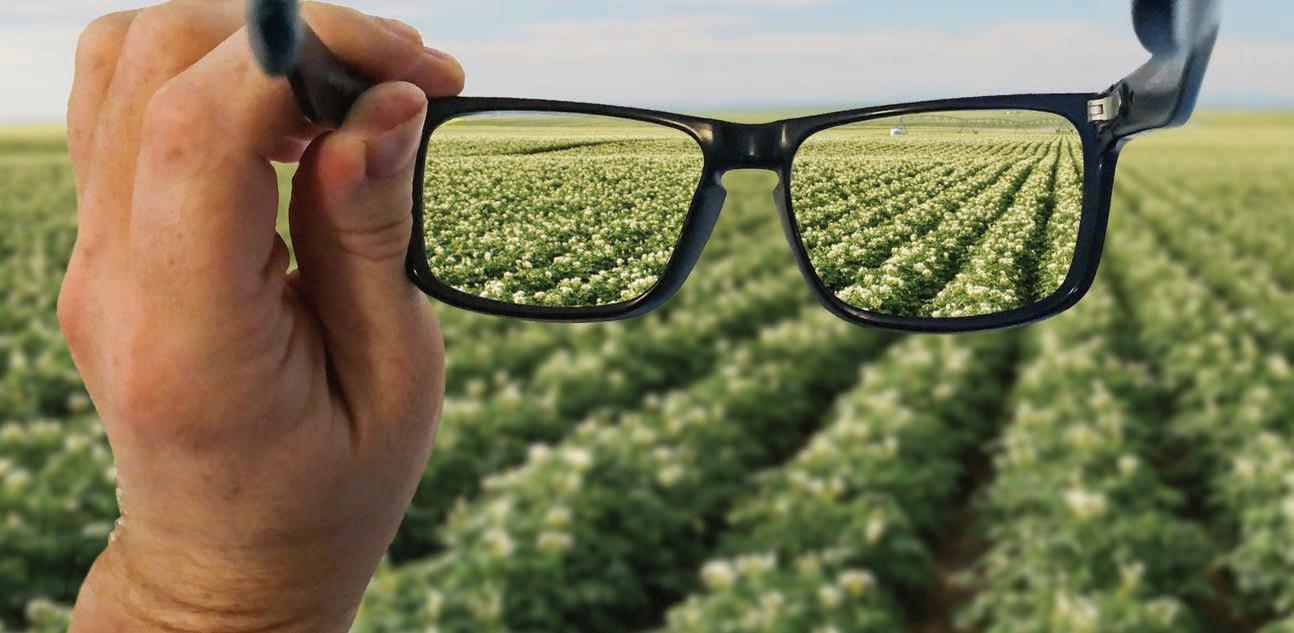
Visit us at corteva.us ®™Trademark of Corteva Agriscience and its af liated companies. Vydate® C-LV is a Restricted Use Pesticide. Vydate C-LV is not registered for sale or use in all states. Contact your state pesticide regulatory agency to determine if a product is registered for sale or use in your state. Always read and follow label directions. ©2023 Corteva
cannot let potatoes be moved out of the vegetable category or the starchy vegetable category. Potatoes have to retain their vegetable classification. But this is the reality we’re dealing with today,” Goldstein said.
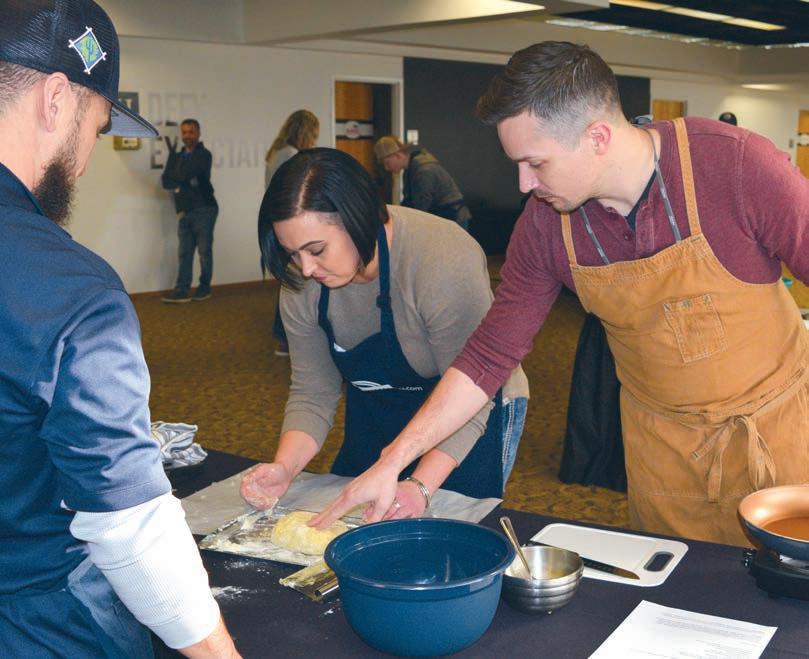
APRE points to a plethora of research proving that a potato is a nutrient-dense vegetable and not a grain. Some of these

studies show that health outcomes of eating potatoes match more closely with starchy vegetables and non-starchy vegetables and have nothing to do with grain foods.
Myth #2: Glycemic Index is Carb Quality Gold Standard



The reason some nutrition scientists
think that potatoes are not a vegetable comes down to the issue of carbohydrate quality, Goldstein continued. Influential nutrition researchers believe that glycemic index (GI) is the gold standard to measure carb quality, which he said is really odd, using this example to illustrate.
“If you were to give yourself or your kids a snack one day and you used the glycemic index as that guide, you would say ‘Peanut M&Ms have a low GI and so do Snickers, so I’ll give that to my kid for a snack instead of a slice of watermelon or a baked potato,’” Goldstein said. “And that is where logic flies out the window. How does this make sense? It really doesn’t.”
Glycemic index, as well as the four other indexes used in the research community to identify high quality carbs, only looks at three components: total carbs, sugar and fiber. The Quality Carbohydrate Coalition, a group spearheaded by Potatoes USA, is working to develop a measurement of carb quality that also takes into account the other essential nutrients that carbohydrates can deliver.
The use of glycemic index to measure carb quality is really the domino that needs to fall, Goldstein said. He mentioned research that demonstrates that GI is not a good marker for carb quality, including studies that show that glycemic index has no impact on health outcomes such as weight, blood pressure, diabetes or heart health.
14 Potato Country • March/April 2023
WASHINGTON-OREGON POTATO CONFERENCE
Chef Ben Leonard (right) gives advice on making the perfect potato gnocchi with wild mushrooms. The dish was prepared during the Washington-Oregon Potato Conference social program.
PLANTERS
2020 Checchi Magli 4 row used, like new
2005 Lockwood 6 row pick planter 6 row 36” x 203
2009 Lockwood 604 Air cup 4 row 34”
2003 Kverneland 3300 cup 6 row 34” pull hitch
2013 Spudnik 8069 bed planter 9 units in 6 row pull Type
2008 Spudnik 8080 Pull type cup, 8 row, 36”
2005 Spudnik 8080 Pull type cup, 8 row 36” rear steer
2004 Spudnik 8060 Cup 6 row 36”
Semi Mount
PLANTER FILLER PILERS
2005 Double L 815 30” x 25’, 18’ swing, 3ph, Hyd.
SEED CUTTERS
Better Built model 448 220 Volt 1ph 48”
2003 Milestone 72” 230 volt 3ph
Milestone 48” 220 volt 1ph, Hyd adjust, elev. Drive, wheel drive
TREATERS
2016 Excel 10” liquid and dry treater 230 V 3ph
2002 Better Built 12” Cannon Duster
1991 Better Built CDT10- 8” Cannon Duster
2008 Milestone 42” Barrel Duster
2008 Milestone 36” Barrel Duster
2003 Milestone 42” Barrel Duster
2005 Milestone MSLT36 36” Liquid Treater
PILERS
1985 Double L 813 31” x 49’ 1ph
belted chain
1997 Double L 813 31” x 49’ 1ph BC
Reconditioned
2003 Grimme SL 8018 30” X 50’
480 Volt 3phase, remote
1998 Spudnik 560 36”BC Elev 480 Volt 3ph
1992 Spudnik 550 30”BC Elev 220 Volt 1ph
1991 Spudnik 550 30”BC Elev 220 volt 1ph
2000 Wemco 36” x 49’ hydraulic variable speed, 3phase
SCOOPERS
1997 Spudnik model 150 30”
1992 Spudnik model 150 30”
1990 Spudnik 100 24” 3ph
1982 Spudnik 100 24” 3ph
POTATO TRUCKS

2004 Kenworth W900 M11 Cum 350hp 15-speed Tran. 26’ bed frame
1997 Peterbilt 377 Cummins diesel, 18spd 20’ bed frame
BULK BEDS/BOXES/ SELF-UNLOADING
1991 Logan 20’ 90-Series Electric
1985 Logan 20B Electric 20’
1998 Spudnik 24’ PTO
1992 Spudnik 20’ Electric
1990 Spudnik 20’ Electric
1990 Spudnik 26’ Electric
1986 Spudik 20’ electric
CROSSOVERS/WINDROWERS
2018 Allan 6 row
2015 Double L 6560 6 row
2009 Double L 951 4row
1996 Double L 851 4 row
2012 Lockwood 554 4 row
1984 Logan 2 row RH BC
2008 Spudnik 6160 6 row R&L discharge
2007 Spudnik 6140 4 row
2001 Spudnik 5140 4 row
1997 Spudnik 5140 4 row
HARVESTERS
2017 Allan 3 row Electric with VFD controls
2018 Double L 7340 4 row
2004 Double L 859 2 row 69”
2003 Grimme SE 75-30
2012 Lockwood 474H 4 row
2012 Spudnik 6640 4 row
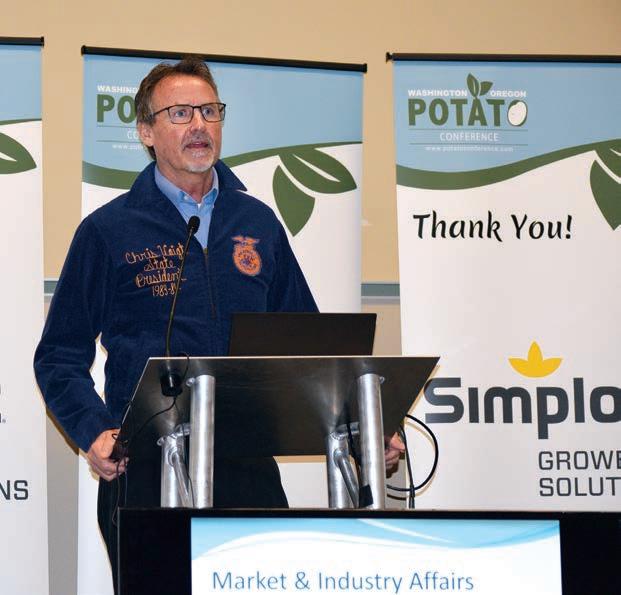
2009 Spudnik 6400 4 row
2008 Spudnik 6200 2 row multi sep
2001 Spudnik 5625 2row 69”
CROP CARTS
2020 Allan AEC 35T, Scott Table
WATER DAMMERS
1985 Ag Engineering 4 row 36”
2019 Logan 6 row Yield Pro 36”
Water Dammer
2014 Logan 8 row Yield Pro 36”
folding wings Water Dammer
STINGERS
2015 Double L 832 36” BC with fingers
2007 Double L 833 30” Belt Chain only
2014 Logan Trac Pro 30” belt only
1994 Spudnik 2230 36” belt only
CONVEYORS TELESCOPIC
1989 Double L 810 Tel. conv. 30” x 50’ 3ph
Milestone 36” x 85’ 230 V 3ph Hyd steer & drive wheel
2013 Spudnik 1250 30”/36” x 60’ 3phase
Spudnik 1255 30”/36”x 85’ TC 220 Volt 1ph
1997 STI 30” x 70’ 3ph Tel. Conv.
CONVEYORS STRAIGHT
Double L 809’s 30” x 40’ 3ph x 6
Mayo 48” x 20’ side shift with 2 – Belt Stingers 30”
Spudnik 1200 30” x 40’ 3ph x 4
Spudnik 1200 30” x 30’ 3ph
Spudnik 1205 30” x 30’ 3ph
SIZER ONLY
1998 Spudnik Model 910 72” acorn rolls 230 volt 3phase, spring adjustable
DIRT ELIMINATOR W/ SIZER
1997 Double 807 Dirt Elim. 62” BC 3ph Stingers 72” Sizer
2013 Milestone Model MSDS 96 BC Elev Sizer clod drum split picking table
2010 Milestone 60” sizing table only w/acorns quick adjust arms
1994 Milestone 72” Dirt Elim. Sizer, 2 – 24” x 12’ stingers
2004 Spudnik 995 DES 72” Q A Dirt & Size roll tables, split picking 230 volt 3ph.
2002 Spudnik 72” DE belt elev
DIRT ELIMINATOR ONLY
2017 Milestone 96” 480 3phase
1998 Double L Model 806 BC, fingers, belt table, 2- pups 230 volt 3ph
2006 Spudnik 995 72”Finger rollers, Ellis table, Belt Chain table 230 Volt 3phase
1990 Spudnik 950 72” 230 volt 3phase
ROCK/CLOD/AIR ELIMINATORS
2013 Harriston 4240 Clod Hopper 3ph
2003 Harriston 200 Clod Hopper 3ph 480 volt Ellis table
EVEN FLOWS/ SURGE HOPPER
New Logan Surge Pro Hoppers 60” 72”
1998 Milestone 45cwt
DIRT TARE PILER
New Logan Dirt Tare Pro 30” 36”
2005 Double L Model 815 30” x 25’ Hyd swing, lift, tip
MISC.
Ace Roll over Hyd. Reset Plow 5 bottom
IH 145 Roll over hyd reset plow 5 bottom
2020 Logan Barrel Washer for little potatoes
Belly Dump Unloader Attachment for Scooper
Evenflows: 1200 cwt, 900 cwt, 400 cwt
Greentronics Scale
Kerian 72” sizer
Mayo 60” flat washer belt chain elevator
Tri Steel 60” felt dryer
Flumes, pumps, rolling tables
NOT COMPLETE LIST CALL OR CHECK OUR NEW SITE
PotatoCountry.com 15 BRUCE: (208)390-5120 | BRUCEN@TRISTEELMFG.COM • EVAN: (208)757-8481 | EVANN@TRISTEELMFG.COM • JOSH: (701)340-4554 | JOSHB@TRISTEELMFG.COM
SPUDEQUIP.COM
Chris Voigt, Washington State Potato Commission executive director, wears his 1983-84 FFA state president jacket while updating the audience on the commission’s work.
Jeff Miller with Miller Research shares tips on fighting foliar foes with fungicides.
Myth #3: Adding Anything to Potatoes Negates Nutrition
Moving on to the final misperception, Goldstein said it’s believed that “if you add anything to a potato, it’s no longer nutritious and it’s going to kill you.” Adding oil or salt to other veggies seems to be fine, but not a potato.
When it comes to potato preparation, much of the research fails to take into account what else the study participants are eating or doing. Often, a health outcome is tied to the background diet or lifestyle more than an individual food. For example, in an APRE study that tested the difference between snacking on almonds – which Goldstein described as the darling of the nutrition world – and French fries, researchers found that based on the study’s outcomes of interest, eating fries is the same as eating almonds. It’s not one food that’s causing poor health outcomes; it’s all that the individual is eating or doing.

Science from APRE is helping push against and get ahead of misperceptions in potato nutrition dialogues, Goldstein said. The organization is using research to prompt media to correct inaccurate reports about potatoes. Progress is being made, but there’s more work to be done.
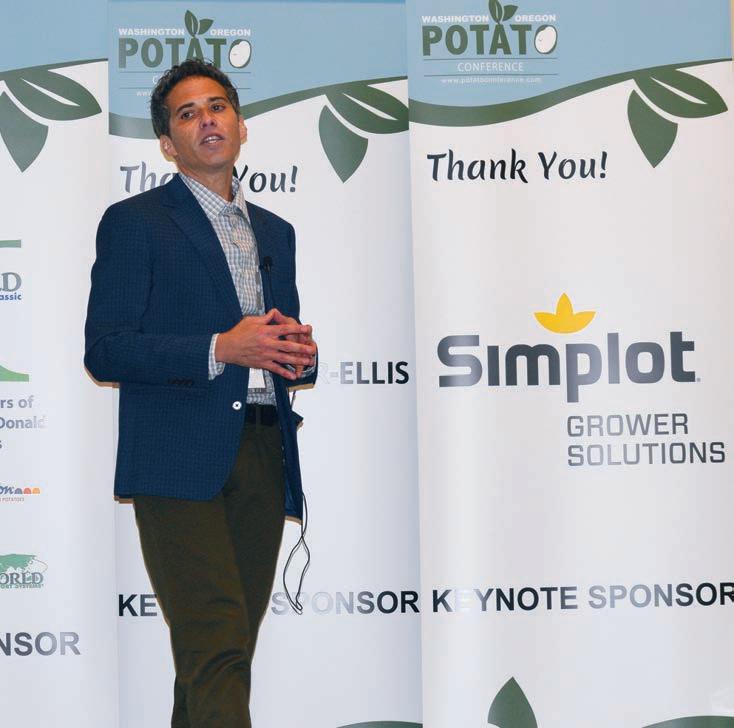
16 Potato Country • March/April 2023
WASHINGTON-OREGON POTATO CONFERENCE
Keynote speaker Howard Goldstein explains how the Alliance for Potato Research & Education is working to debunk three myths about potatoes.
Matt Harris with the Washington State Potato Commission prepares potato gnocchi with his wife, Erin, during the social program at the Washington-Oregon Potato Conference.

Managing Stem Number With Growth Regulators
 By Mike Thornton, Professor of Plant Sciences, University of Idaho
By Mike Thornton, Professor of Plant Sciences, University of Idaho
Potato yield and tuber size distribution are both strongly impacted by environmental conditions and management practices. Size distribution is becoming an increasingly important factor in economic returns as all market sectors incentivize growers to produce tubers in the optimum size range. Nowhere is this more important than in the specialty potato market, where the returns vary greatly based on size class. For example, market prices for tubers in the “C” size class were recently about double compared to those in the “A” class.
One way to manipulate size distribution to get more yield in the most valuable categories is to adjust stem number by application of plant growth regulators. For the past three years, we have been studying the response of the red potato variety Chieftain to two commercially available plant growth regulators that were applied to seed. ProGibb 4% (a gibberellin) is labeled to break dormancy and promote uniform emergence, while Rejuvenate Seed Treatment (an auxin) helps restore apical dominance in aged seed and control stem number. We applied the ProGibb 4% at rates of 0 (water check), 0.5, 1 and 2 ml per ton of seed alone or in combination with 4 ml (0.13 fluid oz) of Rejuvenate. The applications were made in a total spray volume of 0.5 gallons per ton immediately after the seed was cut.
The response to these growth regulator treatments was apparent as soon as the plants started to emerge. ProGibb applications reduced the time to emergence by about seven days compared to the water check (Fig. 1). ProGibb also more than doubled stem number per plant (Fig. 2). Adding Rejuvenate had relatively little impact on emergence rate but tended to reduce stem number per plant by about half a stem compared to what was seen with ProGibb alone. The number of tubers per plant pretty much mirrored the changes
in stem number, with higher rates of ProGibb producing the most tubers per plant and Rejuvenate reducing tuber number very slightly. The net result was that ProGibb had the most impact on tuber size distribution at final harvest. For example, almost 90 percent of the total yield in the water check treatment was in the “A” size class, while the 0.5 ml/ton rate of ProGibb reduced the proportion of “A”s by about one third and doubled the proportion of “B”s and “C”s (Fig. 3).
That all sounds great if you are looking to increase tuber number so that your crop produces more small red potatoes that command higher prices. However, not all the effects of growth regulator applications were positive. The two highest rates of ProGibb caused a lot of deformed stems to emerge that took several weeks to grow out of those symptoms. This delayed growth resulted in about a 10 percent reduction in yield (40 to 50 cwt/acre) at the higher application rates compared to the check.
The tubers were also slightly elongated and not the typical round shape that buyers expect. In our studies, Rejuvenate helped moderate the effects of ProGibb, and it seems advisable to consider using both products together initially until finding the exact combination that works best for a given situation.
After completing this research, we can confidently say that when used at the optimum rate, growth regulators can do desirable things such as speed emergence, optimize stem number and tuber set and, as a result, increase payable yield. However, when applied at too high a rate, they can have negative effects such as slowing plant development, causing deformed tubers and reducing yield. In the next few years, we plan to study how growth regulators can be used in combination with other management tools such as plant spacing and vine kill date to optimize both tuber size distribution and economic returns for specialty potatoes.
18 Potato Country • March/April 2023
0 20 40 60 80 100 Emergence (%) Date 0 0.5 1 2 GA Rate Emergence (%) Date
Figure 1. Emergence rate of Chieftain plants in response to treatment of cut seed with ProGibb 4% prior to planting during 2022
Figure 1. Emergence rate of Chieftain plants in response to treatment of cut seed with ProGibb 4% prior to planting during 2022
The tubers on the left, which were treated with gibberellic acid, are slightly elongated compared to the tubers on the right, which were not treated with gibberellic acid. Long,
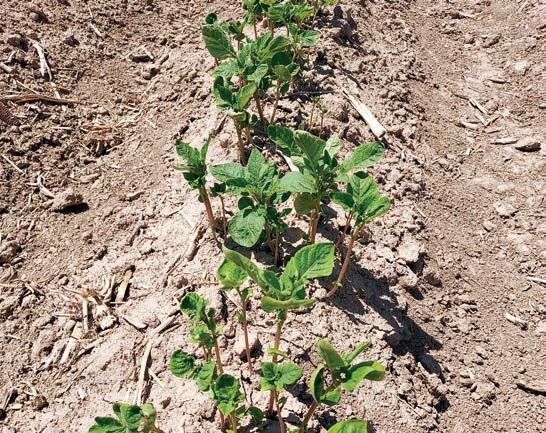
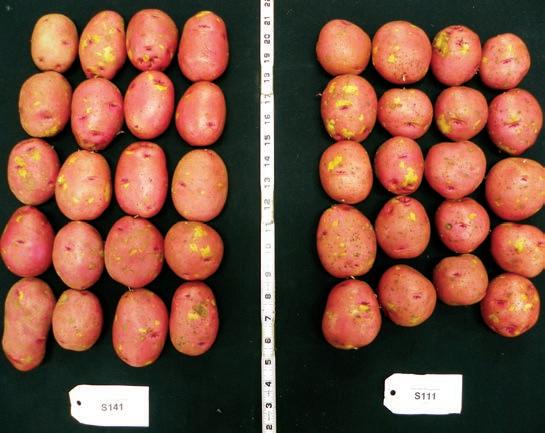




















PotatoCountry.com 19 INCREASES OVERALL POTATO YIELD PROVIDES LONGER STORAGE QUALITY • REDUCES INTERNAL DEFECTS AND WEIGHT LOSS Western States Call Walt Grigg at 509-952-7558 Kent Wasden 208-390-7878 www.nutri-cal.com The NUTRI-CAL Difference Unlocking The Key To Calcium CHEMPORT, INC. 800-247-2480 The NUTRI-CAL Difference
spindly sprouts can result from high rates of gibberellic acid.
Figure 2. Stem number of Chieftain plants in response to treatment of cut seed with four rates of ProGibb 4% (in ml/ton of seed) prior to planting
Figure 3. Size distribution of Chieftain tubers in response to treatment of cut seed with 0 or 0.5 ml/ton of ProGibb 4% prior to planting
2.2 5.7 6.2 6.4 0 1 2 3 4 5 6 7 Stems per plant 0 0.5 1 2
Figure 2. Stem number of Chieftain plants in response to treatment of cut seed with four rates of ProGibb 4% (in ml/ton of seed) prior to planting
0% 30% 60% 90% undersize C's B's A's 0 0.5 Stems per plant
Figure 3. Size distribution of Chieftain tubers in response to treatment of cut seed with 0 or 0.5 ml/ton of ProGibb 4% prior to planting
GROWTH ESSENTIALS BUYERS' GUIDE
AgroLiquid
www.agroliquid.com/agronomics/crops/potato

Pro-Germinator
Proper nutrition is key to maximizing potato yields. However, yield must be balanced against expenses. A season-long supply of phosphorus will help ensure more and larger tubers.
Pro-Germinator, through proprietary manufacturing technology, contains both ortho-phosphate and carbon-protected polymer phosphate to provide readily available and controlled-release phosphorus technology that greatly reduces tie-up in the soil. This means that phosphorus is available to the plant all the way until vine kill. Pro-Germinator can be partnered with nitrogen, potassium and micronutrients for maximum performance.
Crop Vitality

www.cropvitality.com
CaTs
CaTs is a 100 percent water-soluble calcium with a 0-0-10S-6Ca analysis. CaTs applied through the irrigation system can supply much needed calcium and sulfur at critical growth and uptake times. Recent trials with CaTs in the Pacific Northwest have shown both increased yields and improved storability.
ICL Specialty Products Inc.
www.polysulphate.com


Polysulphate
Polysulphate is the only naturally occurring fertilizer delivering four essential nutrients, all in sulfate form: potassium, sulfur, magnesium and calcium. Every granule of Polysulphate contains naturally balanced nutrition for uniform distribution across fields and maximum soil productivity. Low chloride and pH neutral, Polysulphate is extremely safe and ensures potatoes reach their highest quality and yield potential. Polysulphate is well suited for blending with most standard fertilizers and is fully soluble.
20 Potato Country • March/April 2023
JH Biotech
www.jhbiotech.com/chelation-and-mineral-nutrition

Biomin
Biomin is a line of fully chelated plant nutrients resulting from the chelation of mineral nutrients with amino acids. These chelates protect the nutrient from combining with other elements or losing nutrient value for absorption. JH Biotech’s Biomin chelated line is OMRI, CDFA and WSDA organic certified and compatible with humic and fulvic acid products. Without using harsh chemicals, it provides plants with stable nutrients, balancing mineral deficiencies more quickly than conventional inorganic nutrients. It can be used for soil and foliar applications without compromising environmental quality and safety. Biomin may be applied to all crops and turf. It reduces the effects of saline soils, water deficiency and weather conditions while encouraging increased yield, homogeneous ripening, more flavored and high quality fruit, and greater nutrient absorption.
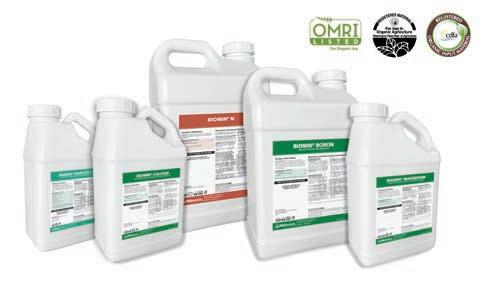
Koch Agronomic Services

www.superufertilizer.com
SUPERU Premium Fertilizer
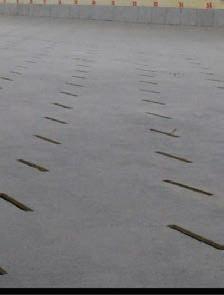

With the efficiency of SUPERU Premium Fertilizer from Koch Agronomic Services, you can protect your nitrogen investment from above- and below-ground losses. SUPERU is a granular, ready-to-use, stabilized urea-based fertilizer that utilizes exclusive N-Tegration Technology to integrate the active ingredients evenly into every granule. This means SUPERU provides consistent nutrient protection and allows for maximum nitrogen uptake. Featuring the highest concentration of nitrogen available in a finished fertilizer, SUPERU contains agronomically effective levels of both a urease and nitrification inhibitor to guard against nutrient loss, helping ensure your crop has nitrogen available when and where it needs it most.

PotatoCountry.com 21
GROWTH ESSENTIALS BUYERS' GUIDE
Nutri-Cal
www.nutri-cal.com
Nutri-K
Nutri-K liquid potassium is a special formulation of highly soluble potassium, carboxylic acids and carbohydrates. The carboxylic acids and carbohydrates, which are the same complexing agents identified in the formulation of NutriCal, are derived from plant extracts in a patented process. There are no nitrates, chlorides or sulfates. It has a low salt index and is therefore non-corrosive.
The product works when the T.O.G. complexes the elemental potassium ion, which subsequently allows the ion to be absorbed directly and immediately through the leaf and fruit cell walls.
Nutri-K T.O.G / liquid potassium complex provides a unique delivery system, which protects the potassium from forming an insoluble compound, enabling more efficient movement of potassium ion to the fruit/vegetable where it is needed most.

Omex
www.omexusa.com


Slyce
Slyce Ca8% provides organic compounds, feeding soil microbial activity, which increases the soil-available fertility, especially when applied after granular fertilizers (e.g., DAP, MAP, CalSul or KCl), by reacting with those granular nutrients to release their components for faster and more efficient fertilizer use by plants.
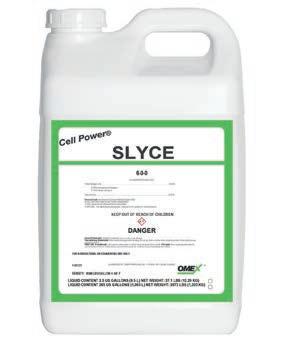
In addition, Slyce aids in water penetration and increases the permeability of the soil profile, providing better soil moisture movement for developing tubers.
Oro Agri
www.oroagriusa.com
Nanocal
Nanocal is a sub-micronized, soil-applied, readily available liquid calcium specifically formulated to be applied at hook to strengthen cell walls, improve tuber quality, increase specific gravity, mitigate storage issues and promote overall crop health. Nanocal should be applied just prior to or at the early stages of tuber initiation to ensure maximum calcium uptake during cellular division. It’s meant as a supplemental source of calcium available to plants during this critical stage of development; it’s not meant to remedy calcium deficiency in soils.
Redox
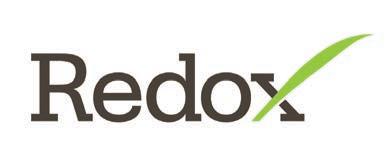
www.redoxgrows.com
RootRx
RootRx (0-0-5) is a botanical extract product that contains 5 percent potassium. RootRx contains proprietary soluble carbon compounds that improve antioxidant production and stimulate root growth and metabolism. RootRx reduces abiotic stress by increasing root quality and quantity, resulting in improved soil health.
22 Potato Country • March/April 2023
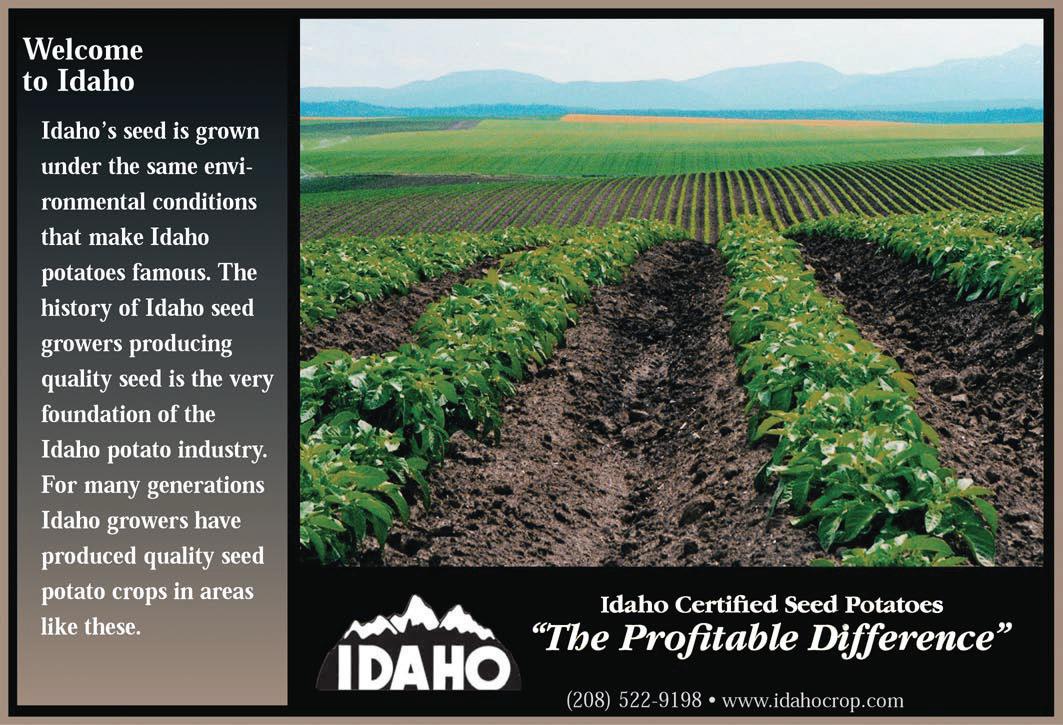


PotatoCountry.com 23
by: Listen on: ThePotatoPodcast.com
Sponsored
2022 Potato Retail Sales Increase
Potato retail sales increased in dollar sales by 14.4 percent but decreased in volume sales by 1.5 percent from January through December 2022 compared to 2021. Despite the slight decrease in volume sales, volume sales remain 3.7 percent above prepandemic levels.

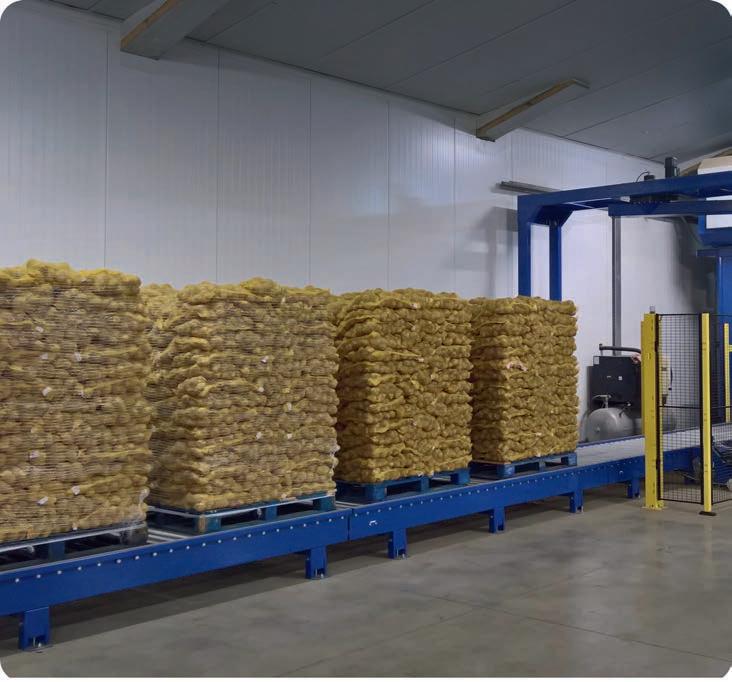
All categories of potatoes increased in dollar sales, with four potato categories rising by double digits. Volume sales were down for all categories of potatoes in the store other than refrigerated and canned potatoes.

Fresh potato dollar sales were up for all types except purple potatoes, which declined in dollars and volume. Yellow potatoes had the most significant increase in dollars (23.8 percent) and were one of two categories to increase in volume (8.5 percent).
In 2022, consumers paid, on average, $2.15 per pound for potatoes. However, prices were the highest from July through September, averaging $2.35 per pound.
Potato LEAF Elects Leaders, Raises Funds
The Potato Leadership, Education and Advancement Foundation (Potato LEAF) has elected Wendy Alsum-Dykstra and Brett Jensen to three-year terms on the board, replacing Dan Moss and Dick Pavelski. Alsum-Dykstra is the chief operating officer of Alsum Farms and Produce in Friesland, Wisconsin, and a member of the Potatoes USA executive committee. Brett Jensen, owner of Brett Jensen Farms in Idaho Falls, Idaho, has served as chairman of the Idaho Potato Commission and Potatoes USA and currently serves on the National Potato Council board of directors.
Gregg Halverson with Black Gold Farms in North Dakota was elected chairman of the board for Potato LEAF, replacing Shelley Olsen of Othello, Washington, who has served as chair for three years. RJ Andrus of Idaho Falls will fill the role of vice chairman.
In addition to electing new leaders, Potato LEAF raised nearly $60,000 during its auction at Potato Expo. The proceeds will fund the foundation’s programs including the Potato Industry Leadership Institute and annual academic scholarship. Since the foundation’s launch in 2000, the industry has contributed more than $2.3 million to the foundation.

24 Potato Country • March/April 2023 IN THE NEWS
INTHE NEWS Need stacking power? Do you need the ability to accumulate boxes with multiple SKUs? Scan the QR to watch our flagship machine VPM-VHV stack pallets at blistering speeds or visit verbruggen-palletizing.com Discover the ultimate potato stacking & palletizing solutions.
Redox CEO Receives Award
Darin Moon, owner, founder and CEO of Burley, Idaho-based Redox Bio-Nutrients, was among the honorees at the Idaho Ag Summit, presented by Leadership Idaho Agriculture. Moon was honored for technical innovation as part of the 28th annual Governor’s Awards for Excellence in Agriculture.

Since founding Redox Bio-Nutrients nearly 30 years ago, Moon has been credited with guiding the company to be at the forefront of technological advancements to help farmers and developing products that are an important tool for sustainable and profitable farming. Customers span across the U.S. and internationally, with Redox products used on a wide range of crops, including potatoes.
CALENDAR
Mar. 13-15
Potatoes USA Annual Meeting
Four Seasons Hotel Denver
Caitlin Roberts
caitlinr@potatoesusa.com
June 6
Ag World Golf Classic
Canyon Lakes Golf Course
Kennewick, Wash.
www.agworldgolf.com
June 8
Ag World Golf Classic
The Links at Moses Pointe Moses Lake, Wash.
www.agworldgolf.com

June 27-29
NPC Summer Meeting
Hyatt Regency Lake Tahoe Resort
Incline Village, Nev.
www.nationalpotatocouncil.org
July 23-27
Potato Association of America Annual Meeting
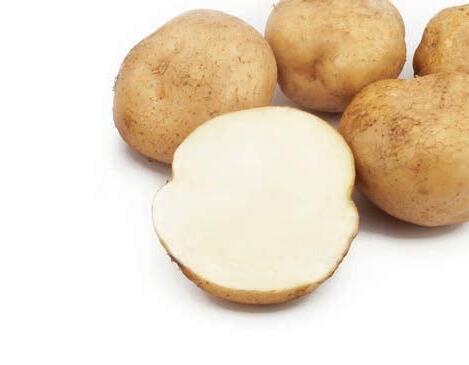
Delta Hotel by Marriott
Charlottetown, Prince Edward Island, Canada www.paaevents.org
Aug. 23
Miller Research Potato Pest Management Field Day
Miller Research
Rupert, Idaho
www.millerresearch.com
PotatoCountry.com 25
Idaho Lieutenant Governor Scott Bedke (left) with Redox Bio-Nutrients CEO, Darin Moon
Certis Expands Copper Product Lineup

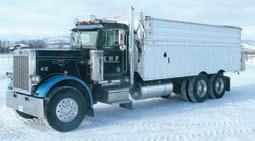


Certis Biologicals has launched its new copper product Kocide 50DF (copper hydroxide) for specialty crops in all states. The high-load copper bio-fungicide is designed to serve as both a preventative and curative product to combat a variety of fungal plant diseases, including early blight and late blight in potatoes.

The new Kocide 50DF formulation mixes with low dust residue, is easy to pour and disperses into the mix solution quickly, producing even coverage during application, according to the company. The product can be applied through foliar, aerial spray, sprinkler chemigation or ground boom application methods.

Visit www.certisbio.com.
Company Adds Drone Disease Detection Service
PomaFresh is offering drone inspections to help growers identify potential potato production problems in the field. Utilizing diffraction to examine subsurface cell structures, the technology provides growers with GPS locations of stressed plants, according to the company. Each disease creates a different optical diffractive signature. Optical signatures include Potato virus Y (PVY), blackleg, Verticillium and cultivation growth rate markers including leaf area growth rate and photosensitivity to monitor nitrogen applications. The company says the technology can also determine if PVY infections are seedborne or insect vectored.

Visit www.pomafresh.com.

Redox Reduces Soil Sampling Time

Redox Bio-Nutrients has incorporated a fleet of ChrysaLabs probes in its soil testing. ChrysaLabs has developed a portable artificial intelligence-based soil health probe that measures 37 soil nutrients and characteristics in real time. The company describes the probes as each containing their own laboratory. Combining a patented spectroscopy interface and the latest AI possibilities, the optical technology measures the soil properties at 360 degrees, with a large contact surface, at any depth, and without preparation. Soil is analyzed in less than a minute, according to the company, saving producers and agronomists time waiting for traditional lab analysis.
Visit www.chrysalabs.com.
Graders, Evenflows, More



26 Potato Country • March/April 2023 See Full Catalog: RiversWestAuction.com Reed Tobol • 406-249-1767 Jason Clinkenbeard • 406-239-3529 Online bidding starts May 1 Live onsite auction - with internet bidding powered by London Hills Farm, LLC Potato Equipment Liquidation AUCTION Friday, June 9, 2023 583 Highway 359 • Cardwell, MT Friday, June 9, 2023 ~ 583 Highway 359 Cardwell, MT Auction Date: Friday, June 9, 2023 - at 1 pm Auction Preview: Onsite Preview ALL WEEK June 5-9 Directions: From Interstate 90, take the Cardwell exit (256) Drive south on Highway 359 to mile marker 7. You will see the auction site at the potato cellars on the left hand side of the road. Auctioneers Note: After 20 years growing Montana Certified Seed Potatoes, the crew at London Hills Farm would like to thank all of their customers and vendors for their help and support over the past two decades. LHF has now decided to discontinue potato production and direct all of their efforts into growing seed grains and other crops as they continue farming in southwest Montana. LOCATION: 583 Highway 359 Cardwell, MT 59721 This will be an onsite live auction with internet bidding powered by EquipmentFacts For photos, more information and upcoming sales, visit: www.riverswestauction.com Don’t Miss This Sale Starts at 1pm MDT Starts at 1:00 pm MDT 35333 Detwiler Rd. Arlee, MT 59821 PRSRTD STD US POSTAGE PAID MISSOULA MT PERMIT #569 On-Site Auction London Hills Farm, LLC Potato Equipment Liquidation AUCTION Friday, June 9, 2023 ~ 583 Highway 359 Cardwell, MT 583 Highway 359 Cardwell, MT 59721 London Hills Farm, LLC Potato Equipment Liquidation AUCTION 2007 Maschio 14ft. Rototiller Pre bidding opens online May 1 Pre bidding opens online May 1 Multiple lots of irrigation pipe Trucks, Harvesters, Trailers, Pilers, Planters, Cutters,
LHF has decided to discontinue potato production and direct all of their efforts into growing seed grains and other crops as they continue farming in southwest Montana.
NEW PRODUCTS
Equipment Dealer Debuts Optical Sorter

The Downs CropVision, a new optical sorter for unwashed potatoes, is now available in the U.S. Fitted with industrial cameras coupled with an artificial intelligence algorithm, the machine analyzes the whole surface of potatoes in order to precisely classify them according to their quality. The sorter can identify good, green, cut, spoiled, misshapen or cracked potatoes, as well as dirt clods, stones and waste. The high-capacity sorter can process up to 100 tons per hour. Visit www.mat-harvesting.com.
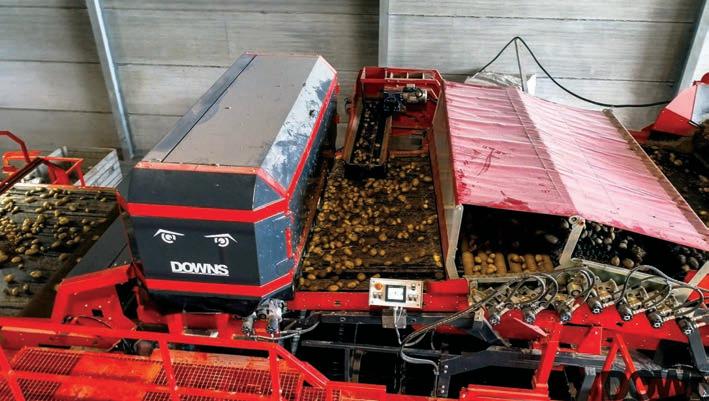
RUSSET VARIETIES:

Russet Norkotah S3
Russet Norkotah S8
Rocky Mountain Russet
Silverton Russet
Rio Grande Russet
Canela Russet
Mesa Russet
Mercury Russet





Fortress Russet
Crimson King
COLORED VARIETIES:

Columbine Gold
Colorado Rose
Rio Colorado
Red Luna
Purple Majesty
Masquerade
Mountain Rose
Vista Gold
Zapata Seed Company
Worley Family Farms
SLV Research Center
San Acacio Seed
Salazar Farms
Rockey Farms, LLC
Pro Seed
Price Farms Certified Seed, LLC
Palmgren Farms, LLC
Martinez Farms
La Rue Farms
H&H Farms
G&G Farms
Bothell Seed
Allied Potato
PotatoCountry.com 27
Lorem ipsum Seed Growers:
Colorado Certified Potato Growers Association P. O. Box 267 Monte Vista, CO 81144 Lyla@ColoradoCertifiedPotatoGrowers.com (719) 274-5996 ColoradoCertifiedPotatoGrowers.com Colorado Certified Potato Growers Association
“Quality as High as our Mountains”
Coming in the next issue of Harvest Essentials Buyers' Guide Don’t miss this issue! Subscribe today at: potatocountry.com/ subscribe 8 issues per year including: • Crop Protection Essentials • Precision Ag Essentials • Storage Essentials • Buyers’ Guide
Factors Driving 2023 Planting Dec
irrigation, fuel and labor. Though fertilizer and fuel prices are currently lower than they were a year ago, other operating expenses are expected to increase in 2023. Labor costs and operating interest are likely to continue upward with rising inflation. Ownership costs are on the rise, as well. Overall, ownership costs rose 16.8 percent above 2021 costs, which put the total cost increase at 17.4 percent. Total production costs climbed as much as 20.3 percent in other parts of Idaho. Other growing areas faced similar increases. Idaho’s cost per cwt was up significantly more due to the 2022-crop yield reductions.
Machinery and equipment
Factors affecting 2023 potato acreage are mixed. Growers have many things to consider when making planting decisions for this year’s potato acreage. Some of the major factors include current and projected potato prices, prices for alternative crops, projected production costs, contract volumes, irrigation water supplies, seed availability and crop rotations. In this article, we review some of the key factors influencing 2023 planting decisions.
Alternative Crop Prices
Record-high open market prices for the 2022 potato crop could encourage growers to plant more acres to potatoes in 2023. The average Idaho Russet
Alternative Crop Price
Grower Return Index from October through December is $17.96 per cwt, up 73.4 percent from $10.36 per cwt a year earlier.
On the other hand, alternative crop prices are stronger than they have been in several years. USDA reports that the national all-wheat price averaged $9.12 per bushel during the October-December period, versus $8.41 per bushel a year ago, an 8.4 percent increase. All-barley and malting barley prices are up 38.6 percent and 42 percent, respectively. Alfalfa prices are up 11.6 percent across the country, at $241 per ton. Corn prices have jumped 24.2 percent to $6.52 per bushel, while soybean prices have risen 14.8 percent to $13.97 per bushel. Strong prices for alternative crops, coupled with rising input costs, could encourage growers to plant fewer acres to potatoes in 2023. The signals are mixed.
Production Costs
Potato production costs are expected to rise again for the 2023 crop, though the jump may not be as large as it was between the 2021 and 2022 crops. Table 3 shows the estimated 2021 and 2022 operating (direct/variable) costs and ownership (indirect/fixed) costs for potato production in southwestern Idaho. Operating costs per acre climbed 17.7 percent. There were significant cost increases last year for seed, fertilizer,
depreciation has been increasing with rising equipment and interest costs. A shift to mechanical sorting due to rising labor costs and workforce availability has encouraged more investment in mechanical sorting. Land rents have been receiving upward pressure as crop prices and farmland values have increased. Rapidly rising production costs and the uncertainty of product availability may cause growers to reconsider potato acreage expansion in 2023.
Other Factors
Several other factors could affect the 2023 U.S. potato acreage. First, processing contract volumes are likely to increase following three years of tight raw product supplies. Both domestic and export demand for French fries and other frozen products has been extremely strong. Frozen product imports from European processors have been record large. Strong finished product prices will encourage fryers to expand production in 2023 so they can maintain or expand their market share.
Second, irrigation water supplies could play a hand in Idaho’s 2023 potato area. Idaho’s irrigation water supply situation improved significantly during January. However, the Upper Snake River reservoir system is the lowest it has been, for this time of year, since 2004. Limited water might discourage potato acreage expansion, while a good water year could do the opposite.
Third, both growers and processors may be less confident in the potential for yields to continue trending upward, following the 2021 and 2022 experience. For the second year in a row, the expected production failed to materialize
28 Potato Country • March/April 2023
MARKET REPORT
Table 1. Four-year history of US potato acreage by state and year-to-year percentage change
US Planted Potato Area 2019-2022 (Thousand Acres) 2019202020212022 2021/22 Change Idaho 310300315295 -6.3% Washington 165155155155 0.0% North Dakota 73 727674 -2.6% Wisconsin 71 696967 -2.9% Maine 52 515452 -3.7% Colorado 51.3 545353 0.0% Michigan 50 464645 -2.2% Oregon 43 454443 -2.3% Minnesota 46 424247 11.9% California 40.5 292619 -26.9% Florida 26 212118 -14.3% Nebraska 20.5 191920 5.3% Texas 1515.51313 0.0% Total Acreage 963.3918.5933901 -3.4% Year/Year Change 0.4%-4.7%1.6%-3.4%
Table 2. Alternative crop price changes from 2021 to 2022 (Source: USDA National Agricultural Statistics Service, Oct.-Dec.)
Changes, 2021-22 20212022 Change Idaho GRI $10.36$17.9673.4% All Wheat $8.41$9.128.4% All Barley $5.34$7.4038.6% Malt Barley $5.31$7.5442% Alfalfa$216.33$241.3311.6% Corn $5.25$6.5224.2% Soybeans$12.17$13.9714.8%
when the Columbia Basin experienced the third-coldest spring and the hottest August on record. Similar conditions held back yields in Idaho.
Fourth, crop rotation requirements typically prevent wide year-to-year swings in potato acreage. Shifts in acreage on a statewide basis are often more variable than the change in acreage on a national level. Year-to-year changes are typically less than 5 percent.
Finally, the country’s overall economic and political conditions may also weigh heavily on planting decisions. Growers across the country are considering the unique financial, production and market risks of growing potatoes this year.
Summary
There are several factors to consider when making planting decisions. Potato prices have been much stronger this year than they have been in the past; however, prices for alternative crops have also been strong. Rising production costs could continue to squeeze profit margins. Even with exceptional crop prices, the profit margins could be slim unless growers monitor costs closely. Other factors such as contract volumes, irrigation water supplies, yield variation, crop rotations and national economic conditions will play into planting decisions this spring.
KEY POINTS
• Rising production costs and financial risk could limit this year’s planted potato area.
• Strong potato prices could encourage growers to expand potato production in 2023; however, strong prices for alternative crops might have the opposite effect.
• Crop rotation requirements, contract volumes, irrigation water supplies and national economic conditions are also factors to consider when making 2023 planting decisions.
By Ben Eborn, Publisher, North American Potato Market News



Idaho Potato Production Costs per Acre, 2021-2022
Agricultural Consulting & Testing
• Soil Testing
• Irrigation Scheduling
• Feed Analysis
PotatoCountry.com 29
• Contract Research • Tissue Testing • Pest Management • Field Research • Grid Sampling • Variable Rate Fertilization • International Testing • Agronomic and CCA Seminars • Nematode Testing Contact: Paul Stukenholtz, Consulting Agronomist Crop Consultants: JP Kruckeberg • Bart Kunz • Cameron Brower Antone Christensen • Wess Gibson • Cody McCoy • Kevin Victor 208-734-3050 • 800-759-3050 PO Box 353 • 2924 Addison Ave E. • Twin Falls, ID 83301 www.stukenholtz.com
ecisions
Table 3. Estimated 2021 and 2022 operating (direct/variable) costs and ownership (indirect/ fixed) costs for potato production in southwestern Idaho Operating Costs 2021 2022Change Seed $410 $545 32.9% Fertilizer $638 $907 42.1% Chemicals $784 $796 1.5% Custom $155 $161 3.9% Irrigation $146 $161 10.7% Machinery (fuel, lube, repairs) $207 $262 26.5% Field Labor $337 $364 8.1% Sorting $94 $77 -18.1% Other $162 $165 1.4% Operating Interest $114 $150 31.5% Total Oper. Costs per Acre $3,048$3,588 17.7% Ownership Costs 2021 2022Change Tractors & Equipment Ins. $7 $7.35 5% Tractors & Equipment D & I $249 $292 17.3% Potato Handling Equip. D & I $94 $165 75.5% Land $735 $800 8.8% Overhead $91 $108 18.3% Management Fee $232 $273 17.6% Total Own. Costs per Acre $1,408$1,645 16.8% Total Cost per Acre $4,456$5,23317.4% Southwestern
WASHINGTON
A Contract Incentive for Leasing Land?
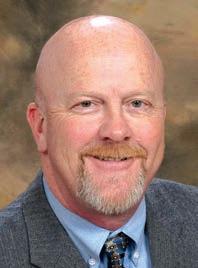 By Dale Lathim, Potato Growers of Washington
By Dale Lathim, Potato Growers of Washington
Over the past couple of years, I have written multiple times about the hyperinflation that growers have been experiencing and the need for contracts to keep up with the rising costs. I also covered the increasing spread between the most efficient growers with more buying power and economies of scale and those who are less fortunate. But another widening gap is occurring between growers who own their own land and those who lease the land that they operate.
Now before anyone gets any ideas about where I am going with this, I fully agree that growers who made the
business decision to buy land at any time should be rewarded for making that vitally important decision. I have never heard of a grower who regretted purchasing land, as they are no longer making farmland. However, many growers have grumbled about what could have been if they had purchased land when it became available. Sometimes making those decisions requires boldness and involves a lot of risk. But so far, land purchase decisions appear to be very wise choices.
When we all sat through Economics 101 in college, we learned about opportunity costs. Growers who own land should be rewarded for the opportunity cost of leasing that ground to someone else to farm. The owner would have no risk and, in today’s market, earn a very good return on the land investment. However, as this hyperinflation has taken place, it has driven more and more agricultural production to the most productive areas of the country including the Columbia Basin.
This added competition for land has pushed the price of both leasing and purchasing land to unprecedented levels. This has resulted in growers who own and operate their own land earning the kind of profits they should have always been receiving. But what about the growers who lease all of the land they operate?
Those growers are still getting a reasonable return above the cost to grow
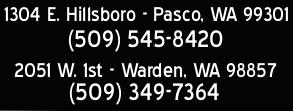

as long as their crop is at least average in yield and quality. That is good and sustainable, but those growers must now compete for any expansions or new opportunities with growers who own their own land. In the past seven years, processors in the Columbia Basin have expanded their operations by more than 1.5 billion pounds of finished product, or more than 40 percent. It is my estimation that they are not through with their expansion plans for the area and more new processing lines will be coming our way over the next few years.
So where did those acres come from to meet the needs of the expansions already in place, and where will the acres come from for the future expansions? Well, the majority of the new acres are land leased or recently purchased by those growers who already own a significant number of acres. Having a land base in place has allowed growers to have significant equity to parlay into additional financing and to spread the lease cost over many more acres than just those being leased in the current year.
The question to me is how far do these growers want to expand, and how consolidated does the processing industry want the grower base becoming? If both sides are fine with the direction this is going, that is great. But if they want to keep most of the growers who lack a land base growing potatoes, we are going to have to address some sort of financial incentive in the potato contracts for leasing more land. What form that incentive takes is still not clear as there is no obvious manner to do this equitably. But without it, I cannot see many of our growers who lease their land being able to compete long term with those who own the majority of their land.
We have some time to work on this issue as it is not a burning one that must be fixed now. But if we do not start discussing and vetting out ideas soon, we will not be prepared for when it does become a hot topic that must be addressed immediately.
30 Potato Country • March/April 2023
IN THE POTATONEWSGROWERS
Ag World ............................17 Bayer ....................................2 Colorado Seed ....................27 Corteva...............................13 Greentronics.......................10 ICL ........................................3 Idaho Potato Comm.. ............9 Idaho Seed .........................23 Montana Seed ....................14 NovaSource ........................25 Nutri-Cal .............................19 Oro-Agri .............................32 Redox .................................11 Rivers West Auctions ..........26 Skone Irrigation ..................30 SpudEquip.com ..................15 Stukenholtz ........................29 The Potato Podcast Sponsored by Vive ..............23 Teleos .................................31 Titan ...................................21 TKI ........................................5 Verbruggen.........................24 ADVERTISER INDEX
OF









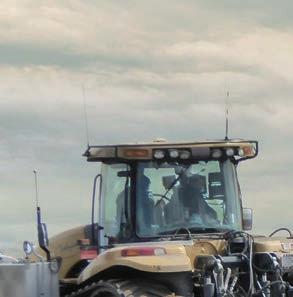

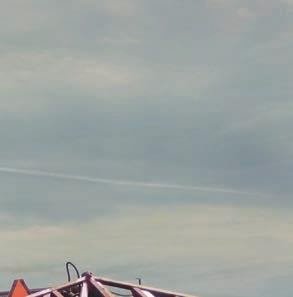
















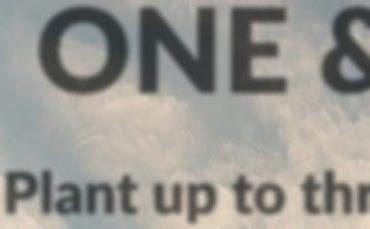


ONE & DONE Plant up to three weeks earlier. STRIKE is a federally Restricted Use Pesticide. TELONE is a Trademark of the Dow Chemical Company (“Dow”) or an affiliated company of Dow, used under license. TELONE is a federally Restricted Use Pesticide. Always read and follow label directions. Contact us today. www.StrikeFumigants.com STRIKE™ is the best pre-plant soil fumigant used to manage Verticillium Wilt. TELONE™ is the gold standard for managing nematodes prior to planting potatoes. TELONE and STRIKE can be dual applied in a one pass application saving time and money.










































































 by Dave Alexander, Publisher
by Dave Alexander, Publisher



 Stetson, Payson and Lindsay Searle from Shelley, Idaho, check out a new John Deere tractor.
Potatoes USA CEO Blair Richardson tells attendees in Pocatello, Idaho, that the number of positive stories about potatoes outweighs the negative by 13 to 1 on social media, 3 to 1 on traditional media.
Logan displays its heavy-duty Tare Pro conveyor at the Eastern Idaho Ag Expo.
Stetson, Payson and Lindsay Searle from Shelley, Idaho, check out a new John Deere tractor.
Potatoes USA CEO Blair Richardson tells attendees in Pocatello, Idaho, that the number of positive stories about potatoes outweighs the negative by 13 to 1 on social media, 3 to 1 on traditional media.
Logan displays its heavy-duty Tare Pro conveyor at the Eastern Idaho Ag Expo.




 Kasia Duellman with the University of Idaho selects toppings at the Teton Russet potato bar during the Idaho Potato Conference. Duellman gave several presentations at the conference.
The French fry table is always a big hit.
It takes several people to push these massive Group Ag electrical cabinets into place under the snarling Idaho State University Bengal tiger.
Kasia Duellman with the University of Idaho selects toppings at the Teton Russet potato bar during the Idaho Potato Conference. Duellman gave several presentations at the conference.
The French fry table is always a big hit.
It takes several people to push these massive Group Ag electrical cabinets into place under the snarling Idaho State University Bengal tiger.


























 Story and photos by Denise Keller, Editor
Story and photos by Denise Keller, Editor


















 By Mike Thornton, Professor of Plant Sciences, University of Idaho
By Mike Thornton, Professor of Plant Sciences, University of Idaho
































































 By Dale Lathim, Potato Growers of Washington
By Dale Lathim, Potato Growers of Washington










































